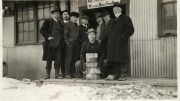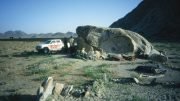Years ago, I had a small, happy-go-lucky crew prospecting for lead and zinc near the village of Five Islands, on the north shore of Minas Basin in Nova Scotia. The mood of the crew changed, however, when a young geologist was added to train as a prospector.
The young geologist, whom I shall refer to as Smith, did not hit it off with the other members of the crew, as he considered prospecting and soil sampling to be beneath him. Smith tried to impress the other lads with his vast geological knowledge, and he seemed to have it in for Billy, a taciturn, burly clam-digger hired to dig till samples.
Billy had dropped out of school at age four to dig clams. One day Smith told me that he thought Billy to be dim-witted, and I curtly responded: “Who cares? He can sure dig many holes, and that’s what we want.”
One shining day, the crew and I were having lunch on the fault scarp overlooking the scenic view of the Minas Basin and the five rugged islands whence the village of Five Islands derived its name.
The regional fault belongs to the Glooscap fault system.
(Before proceeding any further into this yarn, I should mention that we were in Glooscap country. Years ago, as the local legend goes, the region was ruled by a giant Micmac Indian named Glooscap. His reign was fraught with battles involving himself and a giant beaver over control of the area.)
While we were eating, I made a comment that the scenic view was stunning. As if to impress us, Smith went on and on, in great geological detail, about how the movement on the Glooscap Fault over geological periods had influenced the lay of the land and, in particular, the origin of the five rocky islands.
When Smith was through his dissertation, Billy said “I never heard of that there Glooscap fault; when I went to school, the teacher told us that flounders had a lot to do with the origin of this land.”
Before the goggle-eyed Smith could make a comment, Billy went on to tell him the standard version of the legend of Glooscap.
According to Billy, one day when Glooscap and the big beaver were in a scrap, the large native tried to hit the rodent with his mighty hand, but missed. The force of the blow made a great depression in the earth in what is now known as the Bay of Fundy. Glooscap then picked up large chunks of earth and threw them at the Beaver. Billy then pointed one of his big fingers at the five islands before us and said: “Them hunks of rock settled there.” Billy stopped and stared at the now-irrate Smith.
“Well, what do flounders have to do with your foolish story?” responded the geologist. I could see that Smith was being set up.
Billy continued, but added his own twist. The beaver was now really cheesed-off at Glooscap for trying to hit him, so he put a curse on the land and declared an endless winter. All of the lakes in the nearby Cobequid Mountains froze over to great depths and remained frozen for many years. The trout in the lakes became so hungry that they even jumped at the shadows of the birds flying over head. (Billy speculated that these might have been seagulls or crows.) We could all see the anger and the confusion creeping across Smith’s face, but we couldn’t stop laughing.
Billy said that, over time, the heads of the trout became flat after butting themselves against the ice. But when Glooscap finally killed the beaver, the curse was broken, spring came to the region and the trout eventually made their way through the thin ice.
“They hurled themselves over this here mountain into the salt water below and became flat fishes known as flounders,” he claimed, pointing at the Minas Basin.
The prospectors and I laughed so hard, that I thought we would burst. Smith uttered an expletive and stomped off into the bush.
Later, we dropped off Billy at his home and went to a nearby hotel for dinner. During the meal, I mentioned to Smith that Billy sure wasn’t dull. To pour a little salt in the wound, one of the prospectors said “and Billy’s geology story was much more interesting than yours, and it was a great fish story to boot.” Smith uttered that same expletive and went to his room. (Apparently, the rift between the men stemmed from a mutual crush on the same girl in a nearby town.)
The next day, Billy and I were alone in the bush, so I decided to ask him how all the clams got into the tidal flats of the Minas Basin. He looked at me, grinned and said: “How do ya think? When Glooscap threw the earth from the Bay of Fundy, the clams from there settled down here in the Minas Basin.”
No sir, there was nothing dull about Billy the clam digger.
— The author is president of Nova Scotia-based Ecum Secum Enterprises.



Be the first to comment on "Odds ‘n’ sods: A Tall tale"